2004 CHRYSLER 300 M radiator cap
[x] Cancel search: radiator capPage 115 of 277

If the pointer rises to the “H” mark, stop the vehicle and
turn off the engine until the problem is corrected.
CAUTION!
Continuing to drive with an overheated engine cool-
ing system can cause damage to the engine or other
components.
There are steps that you can take to slow down an
impending overheat condition. If your air conditioning is
on, turn it off. The air conditioning system adds heat to
the engine cooling system and turning off the A/C
removes this heat. You can also turn the Temperature
control to maximum heat, the Mode control to Floor and
the Fan control to High. This allows the heater core to act
as a supplement to the radiator and aids in removing heat
from the engine cooling system.
16. Malfunction Indicator Light
This light is part of an onboard diagnostic
system called OBD that monitors engine and
automatic transmission control systems. Thelight will illuminate when the key is in the ON
position before engine start. If the bulb does not come
on when turning the key from OFF to ON, have the
condition checked promptly.
Certain conditions such as a loose or missing gas cap or
poor fuel quality may illuminate the light after engine
start. The vehicle should be serviced if the light stays on
through several of your typical driving cycles. In most
situations the vehicle will drive normally and will not
require towing.
The Malfunction Indicator Light flashes to alert to serious
conditions that could lead to immediate loss of power or
severe catalytic converter damage. The vehicle should be
serviced as soon as possible if this occurs.
17. Trip Odometer Reset Knob
To reset the trip odometer, push the reset knob for about
two seconds.
18. Airbag Light
The light will come on and remain on for 6 to 8
seconds as a bulb check when the ignition switch
is first turned ON. If the bulb is not lit during starting,
UNDERSTANDING YOUR INSTRUMENT PANEL 115
4
Page 183 of 277
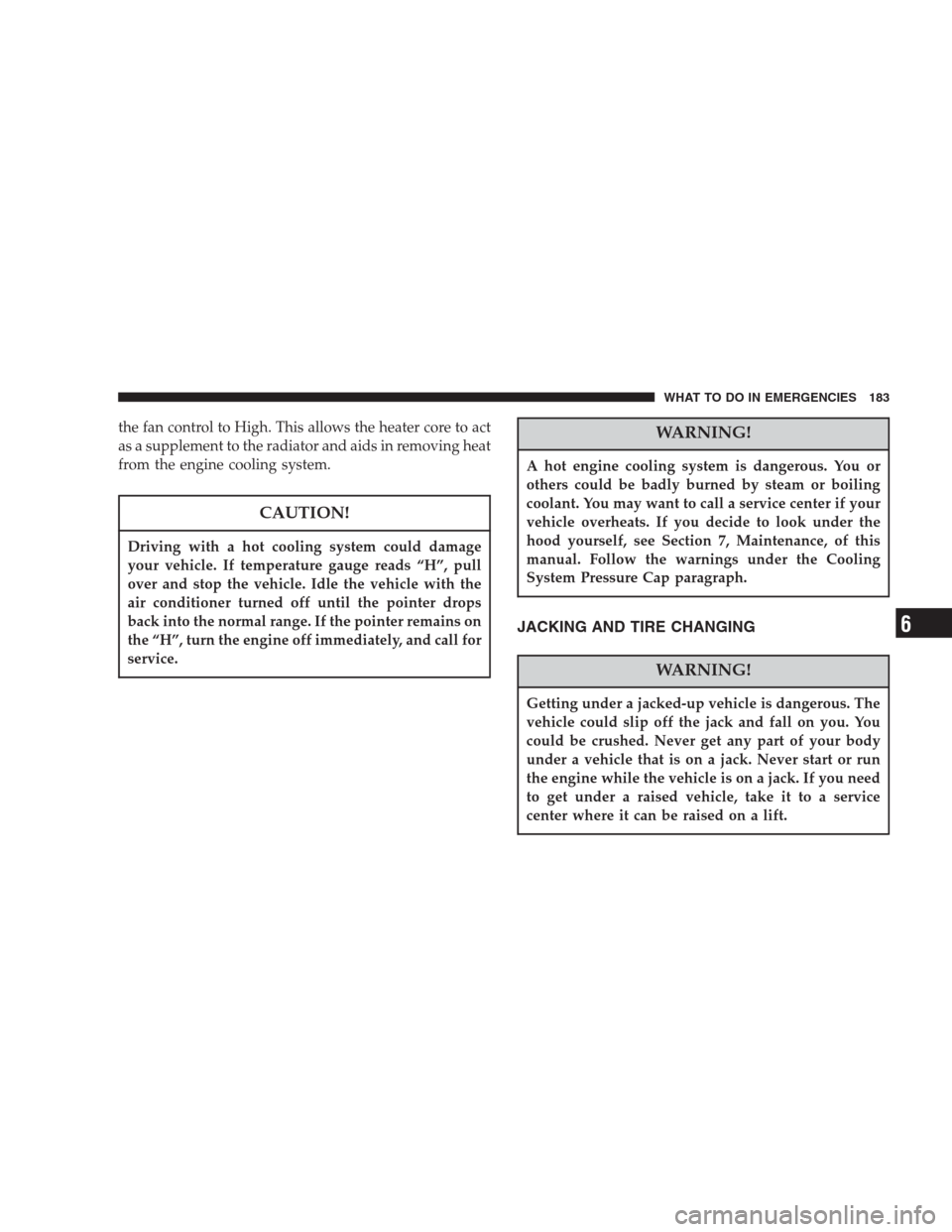
the fan control to High. This allows the heater core to act
as a supplement to the radiator and aids in removing heat
from the engine cooling system.
CAUTION!
Driving with a hot cooling system could damage
your vehicle. If temperature gauge reads “H”, pull
over and stop the vehicle. Idle the vehicle with the
air conditioner turned off until the pointer drops
back into the normal range. If the pointer remains on
the “H”, turn the engine off immediately, and call for
service.
WARNING!
A hot engine cooling system is dangerous. You or
others could be badly burned by steam or boiling
coolant. You may want to call a service center if your
vehicle overheats. If you decide to look under the
hood yourself, see Section 7, Maintenance, of this
manual. Follow the warnings under the Cooling
System Pressure Cap paragraph.
JACKING AND TIRE CHANGING
WARNING!
Getting under a jacked-up vehicle is dangerous. The
vehicle could slip off the jack and fall on you. You
could be crushed. Never get any part of your body
under a vehicle that is on a jack. Never start or run
the engine while the vehicle is on a jack. If you need
to get under a raised vehicle, take it to a service
center where it can be raised on a lift.
WHAT TO DO IN EMERGENCIES 183
6
Page 214 of 277
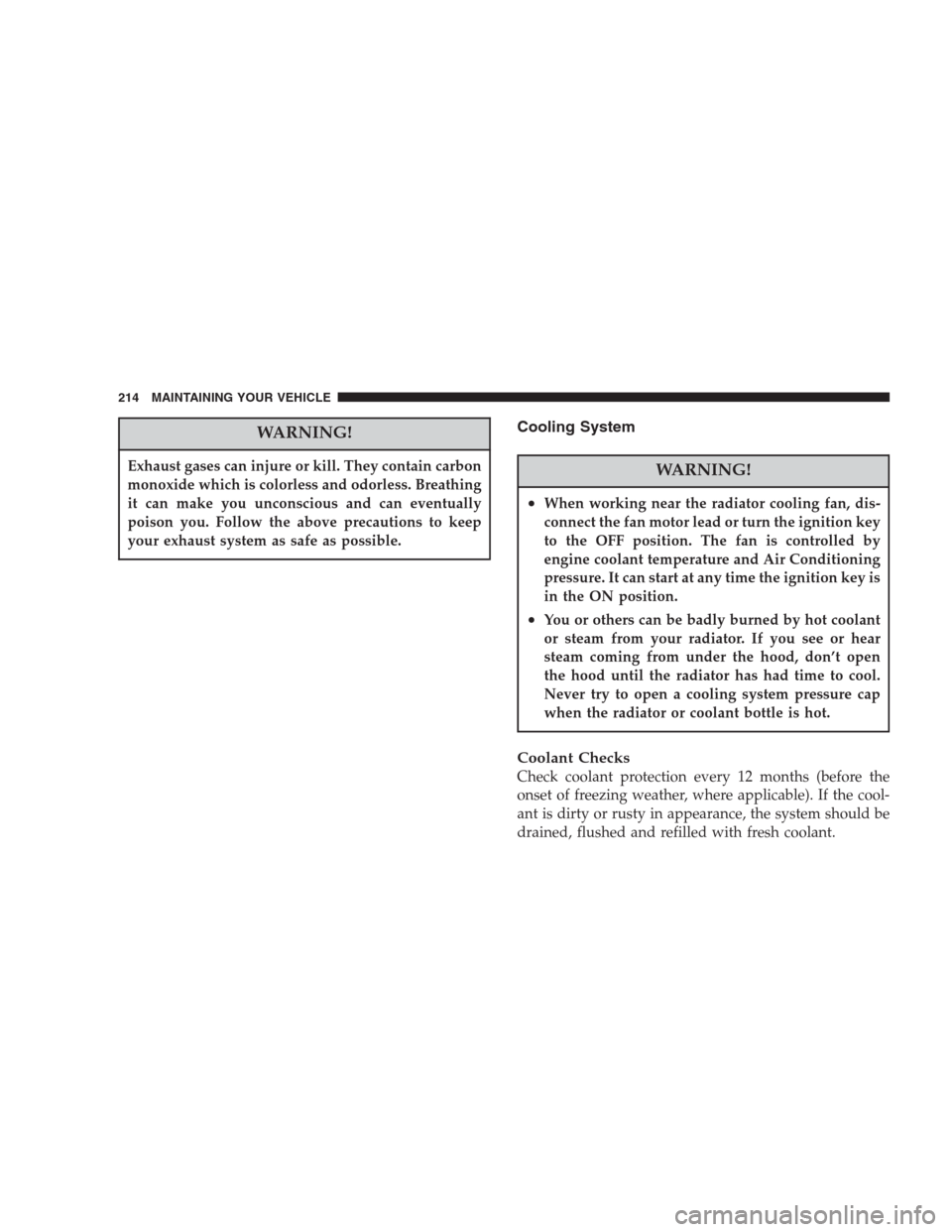
WARNING!
Exhaust gases can injure or kill. They contain carbon
monoxide which is colorless and odorless. Breathing
it can make you unconscious and can eventually
poison you. Follow the above precautions to keep
your exhaust system as safe as possible.
Cooling System
WARNING!
•When working near the radiator cooling fan, dis-
connect the fan motor lead or turn the ignition key
to the OFF position. The fan is controlled by
engine coolant temperature and Air Conditioning
pressure. It can start at any time the ignition key is
in the ON position.
•You or others can be badly burned by hot coolant
or steam from your radiator. If you see or hear
steam coming from under the hood, don’t open
the hood until the radiator has had time to cool.
Never try to open a cooling system pressure cap
when the radiator or coolant bottle is hot.
Coolant Checks
Check coolant protection every 12 months (before the
onset of freezing weather, where applicable). If the cool-
ant is dirty or rusty in appearance, the system should be
drained, flushed and refilled with fresh coolant.
214 MAINTAINING YOUR VEHICLE
Page 216 of 277
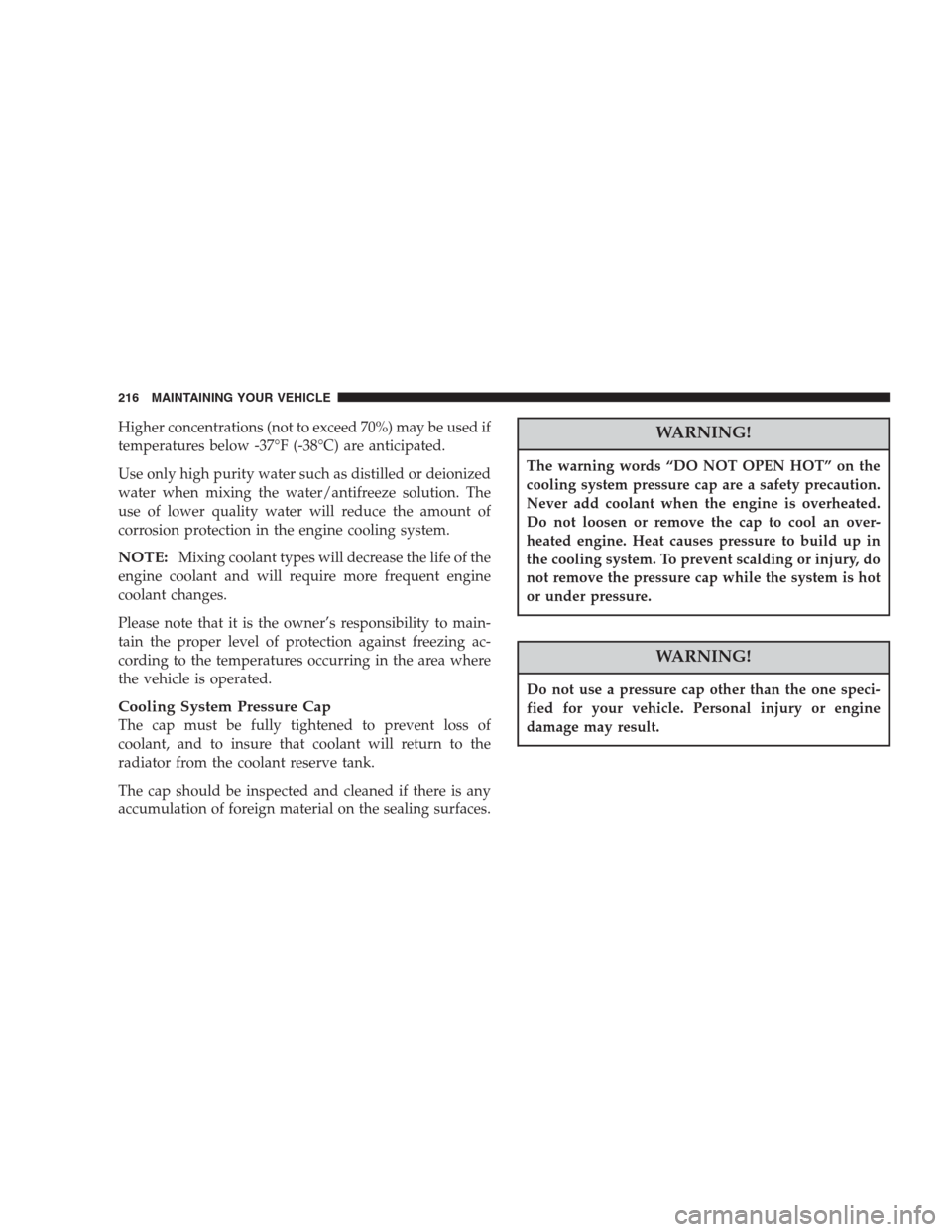
Higher concentrations (not to exceed 70%) may be used if
temperatures below -37°F (-38°C) are anticipated.
Use only high purity water such as distilled or deionized
water when mixing the water/antifreeze solution. The
use of lower quality water will reduce the amount of
corrosion protection in the engine cooling system.
NOTE:Mixing coolant types will decrease the life of the
engine coolant and will require more frequent engine
coolant changes.
Please note that it is the owner’s responsibility to main-
tain the proper level of protection against freezing ac-
cording to the temperatures occurring in the area where
the vehicle is operated.
Cooling System Pressure Cap
The cap must be fully tightened to prevent loss of
coolant, and to insure that coolant will return to the
radiator from the coolant reserve tank.
The cap should be inspected and cleaned if there is any
accumulation of foreign material on the sealing surfaces.
WARNING!
The warning words “DO NOT OPEN HOT” on the
cooling system pressure cap are a safety precaution.
Never add coolant when the engine is overheated.
Do not loosen or remove the cap to cool an over-
heated engine. Heat causes pressure to build up in
the cooling system. To prevent scalding or injury, do
not remove the pressure cap while the system is hot
or under pressure.
WARNING!
Do not use a pressure cap other than the one speci-
fied for your vehicle. Personal injury or engine
damage may result.
216 MAINTAINING YOUR VEHICLE
Page 268 of 277
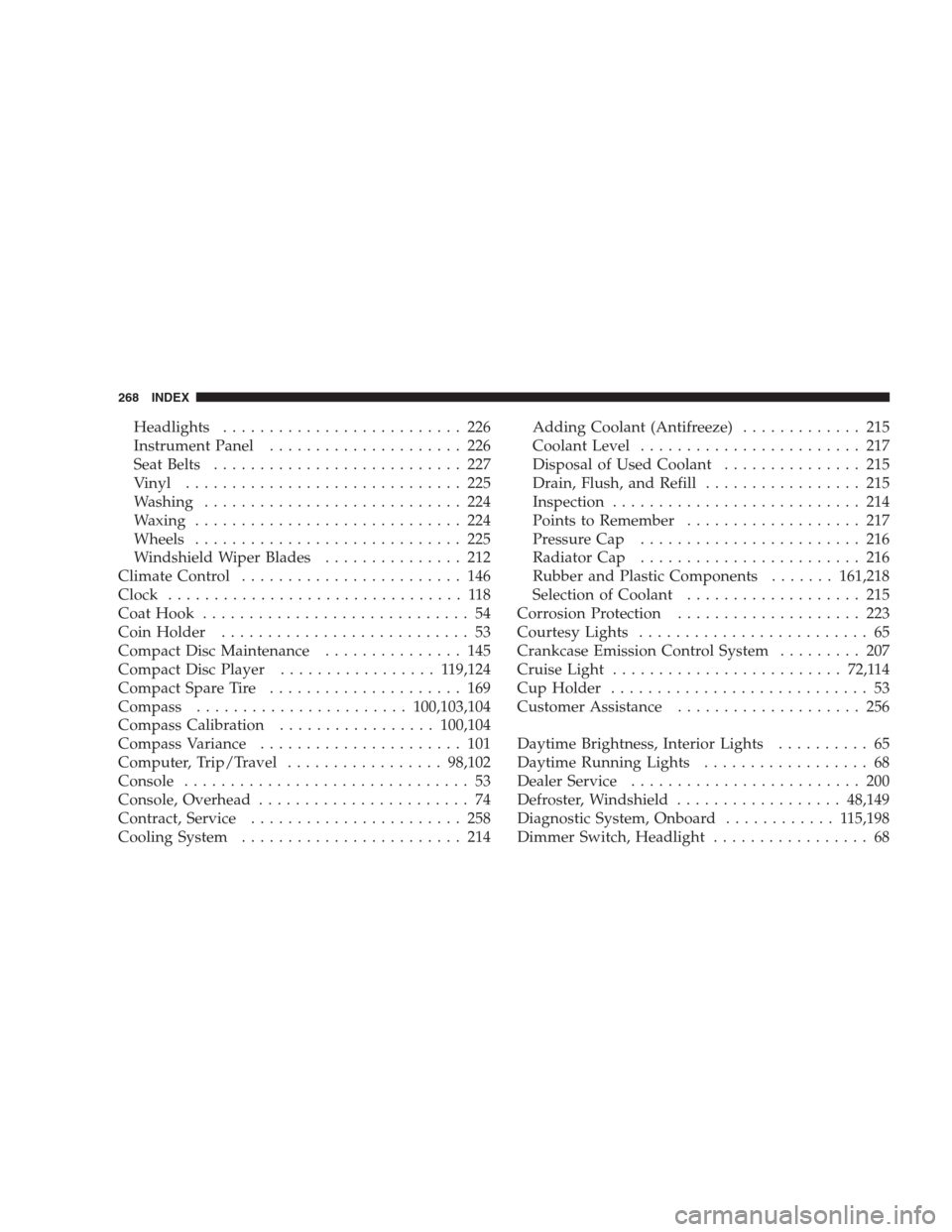
Headlights.......................... 226
Instrument Panel..................... 226
Seat Belts........................... 227
Vinyl.............................. 225
Washing............................ 224
Waxing............................. 224
Wheels............................. 225
Windshield Wiper Blades............... 212
Climate Control........................ 146
Clock................................ 118
Coat Hook............................. 54
Coin Holder........................... 53
Compact Disc Maintenance............... 145
Compact Disc Player................. 119,124
Compact Spare Tire..................... 169
Compass.......................100,103,104
Compass Calibration.................100,104
Compass Variance...................... 101
Computer, Trip/Travel.................98,102
Console............................... 53
Console, Overhead....................... 74
Contract, Service....................... 258
Cooling System........................ 214Adding Coolant (Antifreeze)............. 215
Coolant Level........................ 217
Disposal of Used Coolant............... 215
Drain, Flush, and Refill................. 215
Inspection........................... 214
Points to Remember................... 217
Pressure Cap........................ 216
Radiator Cap........................ 216
Rubber and Plastic Components.......161,218
Selection of Coolant................... 215
Corrosion Protection.................... 223
Courtesy Lights......................... 65
Crankcase Emission Control System......... 207
Cruise Light.........................72,114
Cup Holder............................ 53
Customer Assistance.................... 256
Daytime Brightness, Interior Lights.......... 65
Daytime Running Lights.................. 68
Dealer Service......................... 200
Defroster, Windshield..................48,149
Diagnostic System, Onboard............ 115,198
Dimmer Switch, Headlight................. 68
268 INDEX
Page 274 of 277
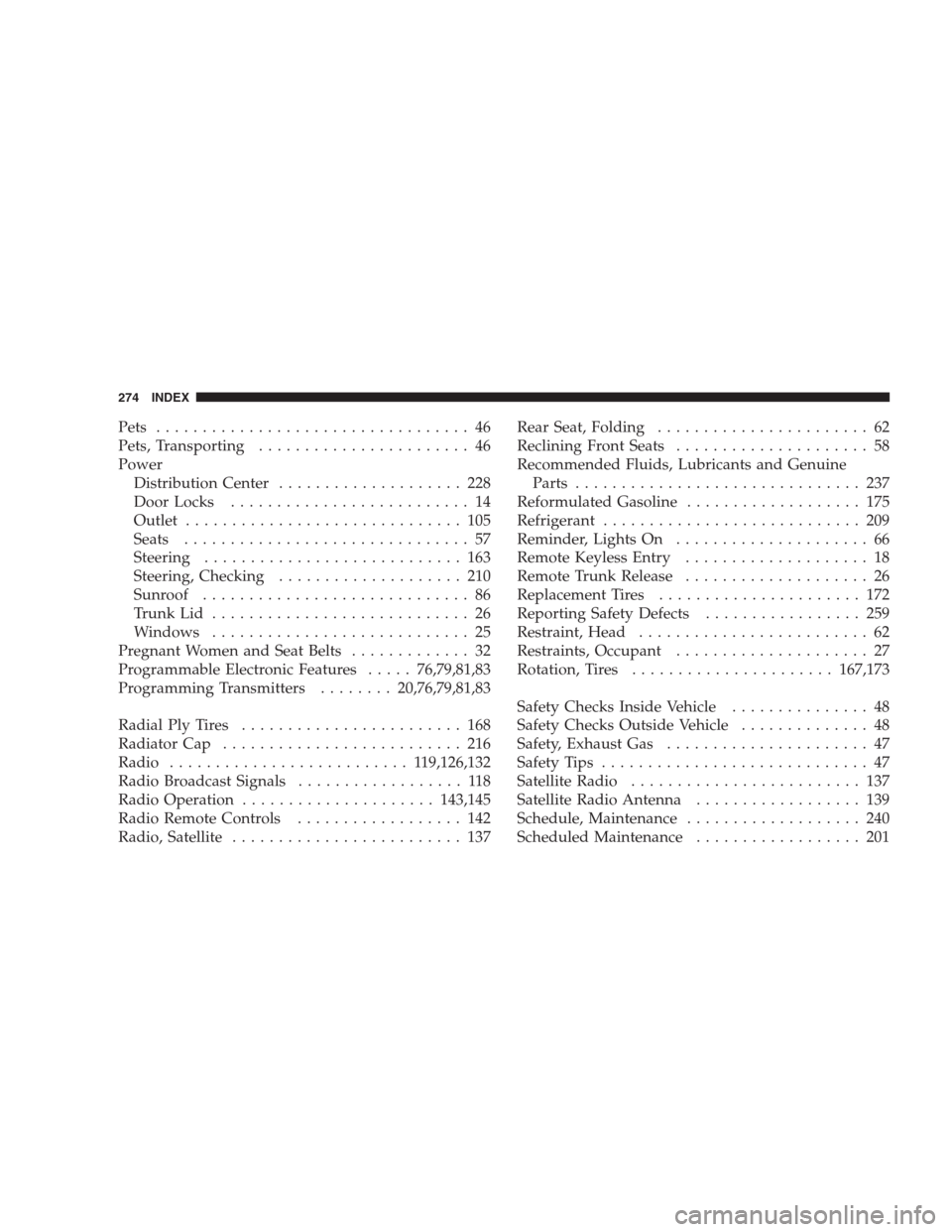
Pets.................................. 46
Pets, Transporting....................... 46
Power
Distribution Center.................... 228
Door Locks.......................... 14
Outlet.............................. 105
Seats............................... 57
Steering............................ 163
Steering, Checking.................... 210
Sunroof............................. 86
TrunkLid ............................ 26
Windows............................ 25
Pregnant Women and Seat Belts............. 32
Programmable Electronic Features.....76,79,81,83
Programming Transmitters........20,76,79,81,83
Radial Ply Tires........................ 168
Radiator Cap.......................... 216
Radio.......................... 119,126,132
Radio Broadcast Signals.................. 118
Radio Operation.....................143,145
Radio Remote Controls.................. 142
Radio, Satellite......................... 137Rear Seat, Folding....................... 62
Reclining Front Seats..................... 58
Recommended Fluids, Lubricants and Genuine
Parts............................... 237
Reformulated Gasoline................... 175
Refrigerant............................ 209
Reminder, Lights On..................... 66
Remote Keyless Entry.................... 18
Remote Trunk Release.................... 26
Replacement Tires...................... 172
Reporting Safety Defects................. 259
Restraint, Head......................... 62
Restraints, Occupant..................... 27
Rotation, Tires......................167,173
Safety Checks Inside Vehicle............... 48
Safety Checks Outside Vehicle.............. 48
Safety, Exhaust Gas...................... 47
Safety Tips............................. 47
Satellite Radio......................... 137
Satellite Radio Antenna.................. 139
Schedule, Maintenance................... 240
Scheduled Maintenance.................. 201
274 INDEX